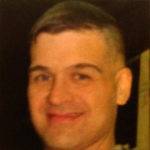 Author Lt Col Robert Keith Gunther concludes his fascinating look back at events of 51 years ago and the State Funeral of President John F Kennedy. Here he looks at the role played by the pipe band of the United States Air Force in that defining moment in history….
Author Lt Col Robert Keith Gunther concludes his fascinating look back at events of 51 years ago and the State Funeral of President John F Kennedy. Here he looks at the role played by the pipe band of the United States Air Force in that defining moment in history….
The USAF Pipe Band was originally founded in 1950 by Colonel George S. Howard. An article from September 13, 1963, states that it was composed ‘exclusively of players of Scottish and Irish ancestry, attired in authentic kilts of the Mitchell tartan. The band alternated playing with the bugle section of the USAF Drum and Bugle Corps while on the march and during field exhibitions’.
According to U.S. Air Force Piper Jerry Cashion, the USAF Pipe Band was in New Orleans when JFK was assassinated. The band had arrived the day before, toured Bourbon Street, and now the men were relaxing in Navy barracks. They were preparing for an evening show when they were given the bad news. The Pipe Major received a call from Washington ordering the band’s immediate return to Bolling Air Force Base.
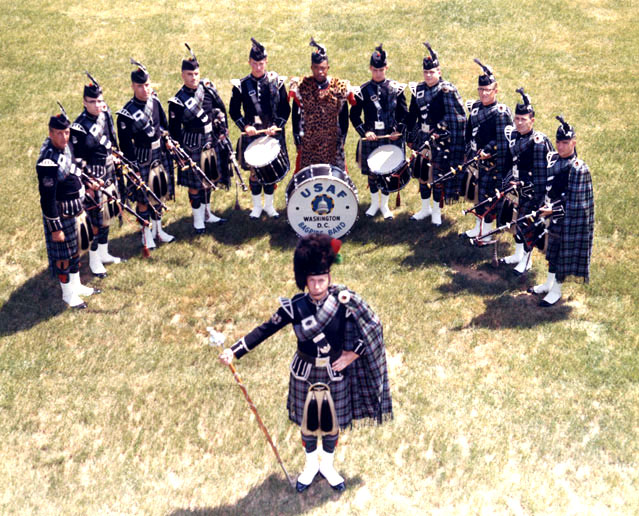
In Geoff Redick’s article ‘Local Bagpiper recalls JFK’s funeral’, Piper Cashion said, ‘We were in a gymnasium, ready to play a job down in New Orleans, Louisiana, and we were getting dressed, ready to go. An announcement came over the loudspeaker that Kennedy had been shot. Immediately, they packed us up and brought us back to Washington, D.C. We had to stay on base all weekend, and learn this new tune they told us we had to play ‘Mist Covered Mountain’. The band learned it quickly and practiced the ceremonial march ahead of the funeral on November 25 during that cold Monday. Because of the President’s fondness for pipe music, The USAF Pipe Band was directed to play at the interment ceremony.
‘Monday, November 25 turned out to be a bright, sunny, but a very cold day. The band reported to Arlington in the early morning for a run-through of the graveside ceremonies to take place later that day.’
‘We rehearsed in our full outfits and it was cold as hell,’ recalled Sgt. John Bosworth. After their dry run, the band moved to an area near the Old Amphitheater to run through the music and marching one more time to ensure perfection.
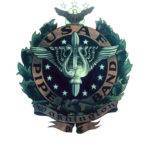 The band then positioned themselves on the hill in front of the Custis-Lee Mansion. It was a perfect viewpoint from which to watch the magnificent, solemn, pageantry of a State Funeral unfold. Sergeant Bosworth related that they were waiting for about an hour and a half and could see each marching unit as it approached the gates to Arlington National Cemetery. Upon arrival of the cortege at Arlington, the Marine band began the graveside rites with ruffles and flourishes and the National Anthem. When it ended, the Air Force pipe band began.
The band then positioned themselves on the hill in front of the Custis-Lee Mansion. It was a perfect viewpoint from which to watch the magnificent, solemn, pageantry of a State Funeral unfold. Sergeant Bosworth related that they were waiting for about an hour and a half and could see each marching unit as it approached the gates to Arlington National Cemetery. Upon arrival of the cortege at Arlington, the Marine band began the graveside rites with ruffles and flourishes and the National Anthem. When it ended, the Air Force pipe band began.
Irving Lowens wrote: ‘At 2:43 p.m as the coffin was moved from the caisson to the burial site, the Air Force Pipers played the Mist Covered Mountains. The band slowly marched by the grave and onto the street. They were led by Drum Major Seamus (Jim) Neary. ‘Overhead, fifty jet fighters flew in formation followed by Air Force One. After the funeral, the band returned to Bolling Air Force Base with the knowledge that they had contributed to a momentous event.’ The USAF Pipe Band performance (and the 50 jets flying overhead) can be watched at 32 mins, 27 secs into this 34-minute clip: http://www.youtube.com/watch?v=3KJQkn6zUvM.
As stated in the ‘Last Salute’, ‘In a wide departure from customary graveside procedure in which a band, standing fast in formation, plays an appropriate hymn as the casket is carried from the caisson to the grave, Mrs. Kennedy preferred that the Air Force Bagpipe Band march past the gravesite playing Mist Covered Mountain while the movement of the casket was taking place. The Air Force group was so scheduled, and a route permitting the group to perform as requested was marked out at the gravesite.’
Piper Cashion: ‘Being at the graveside, piping, I think the thing that got me the most was the 50 thunder jets that flew over, right after we played. It was very moving. And I was very proud to be there.’
The USAF Pipe Band Roster for the JFK State Funeral included (as originally lined up) SSgt James Neary, Drum Major, SSgt N. B. ‘Sandy’ Jones, A1C Tom Kirkpatrick, TSgt Melvin (‘Mel’) Ross, SrA ‘Jack’ McGilvary, TSgt George Lucas, A1C Jerry Cashion, SrA Robert (‘Bob’) Fulton, SrA Richard (‘Dick’) Rau, SSgt John Ryan, SSgt Leroy Carroll (Bass Drum), SrA Ward Willis, SSgt John G. Bosworth.

Drum Major James ‘Seamus’ Neary, the son of an Irish immigrant, was also a piper, but ended up as the USAF Pipe Band Drum Major. Neary actually started out in the U.S. Army as a piper from 1955-1958 with the 2nd Army Pipe Band. He then joined the USAF Pipes & Drums from 1958-1976. He recalls the first time playing for JFK was when he was President-Elect in an Ice Arena. Neary was friends with Liam Clancy and Tommy Makem and details a party the famous Irish folk singers came to with the USAF band after their performance at the JFK White House on St. Patrick’s Day 1963.
Norval ‘Sandy’ Jones, according to the North American Academy of Piping website, began piping at the age of eight under George Mars of Victoria, British Columbia, Canada. He served as the Pipe Major for the U.S. Air Force band for eight years. As a member of the pipe band he often performed for Presidents, Heads of State, and dignitaries of foreign nations. During his tenure in the air force he continued his studies of the bagpipe with Jack Chisholm of Inverness, Scotland, and John MacFadyen. In 1970, he and John MacFadyen, co-founded the North American Academy of Piping. Sandy is the author of the tutor ‘Beginning the Bagpipe‘. He travels throughout North America judging at Highland games, conducting workshops, and performing at recitals. He retired from The Citadel in Charleston, SC, where he taught bagpipes for 25 years. Currently he is active with the Grandfather Mountain Highland Games and the Charleston Scottish Games.
[easyrotator]erc_14_1414056032[/easyrotator]Gerald Cashion joined the USAF Pipe Band in 1960. In 1961, Cushion was chosen to be a White House piper on call for ceremonial duties . Upon leaving the military, he returned to Glens Falls, New York, where he taught English for thirty years. During that time, he was Pipe Major of the Adirondack Pipes and Drums of Glens Falls, as well as the Galloway Pipe Band. He was taught by Hugh MacInnes and Sandy Jones.
Piper Tom Kirkpatrick, from Glens Falls, NY, also played that day. From 1960-1965, he was part of many events at the White House such as the state dinner for the Prime Minister of Ireland and the Dulles Airport Dedication Ceremony.
Piper Robert Fulton was one of only two sword dancers the band ever had during its existence. He learned the pipes from John Irvin, 1st Battalion Queens Own Cameron Highlanders in 1952. Fulton played with the Caledonian Pipe Band of Cleveland, Ohio, from 1952 until 1960. Piper Fulton learned the Sword Dance, Broad Swords, Highland Fling, Hornpipe and Sean Truibhais from one of the dancers that danced with the Caledonian Pipe Band.
Drum Sergeant John Bosworth retired from the USAF band in 1984 as a Senior Master Sergeant and is still quite active as a percussionist. The drum he used in the Kennedy funeral was on display at Arlington National Cemetery for three years, according to www.tapsbugler.com.
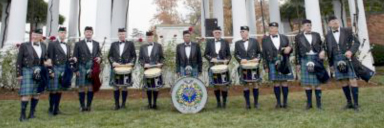 On November 16 last year, former members of the U.S. Air Force band, some of whom played at JFK’s funeral in 1963, held a commemoration (above). This gathering also honoured the memory of Army bandsman Keith C. Clark, who played Taps at the funeral 50 years ago.
On November 16 last year, former members of the U.S. Air Force band, some of whom played at JFK’s funeral in 1963, held a commemoration (above). This gathering also honoured the memory of Army bandsman Keith C. Clark, who played Taps at the funeral 50 years ago.
Read more: http://www.dvidshub.net/image/1055389/historical-reunion-military-bagpipers-50th-anniversary-president-kennedys-funeral#ixzz2p3SaCFJA
Conclusion
Although collective memory of the JFK presidency culminates with the sound of the great Highland bagpipe carrying this much-loved young American President to his early grave, our instrument’s sound and music were also heard during the numerous colourful days of his presidency. Pipers were present at the first and last official state events and at numerous others in between. Our instrument was heard during the brightest days of President Kennedy’s administration and added to the splendour of his ‘Camelot’. The most celebrated moment was the Black Watch performance on the South Lawn I wrote about in my last excerpt.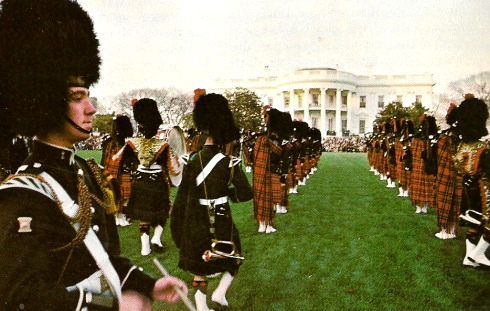 The bagpipe’s presence during the state funeral reflected the high regard the instrument was held in by the Kennedy family, amply demonstrated by the unprecedented honour of inclusion of a foreign military unit in the State Funceral ceremony.
The bagpipe’s presence during the state funeral reflected the high regard the instrument was held in by the Kennedy family, amply demonstrated by the unprecedented honour of inclusion of a foreign military unit in the State Funceral ceremony.
Through these articles I hope I have established that the idea that there was only one pipe band at the funeral is incorrect. There were two distinct units, the Black Watch pipers and the USAF Pipe Band.
The Highland bagpipe’s prominence during the Kennedy Presidency should be historically re-evaluated in order to correct its image in the eyes of Americans. Unfortunately, we still only associate this versatile instrument with funerals, whilst in Scotland it is often present at all types of social and public events. Perhaps this because of our memories of President Kennedy’s funeral. My hope is that this series will dispel the incorrect notions surrounding our instrument and correctly reflect its prominent, and respected position during the Kennedy presidency.
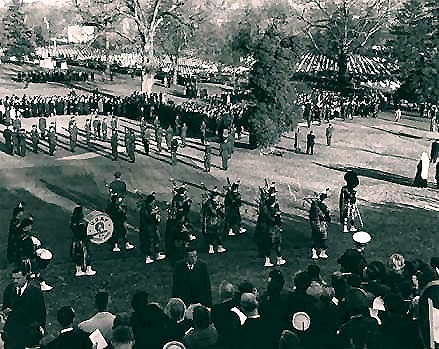
PP Editor Robert Wallace: I would like to thank Lt Col Gunther, US Army, for all the hours of research and hard work he has put into the production of this series. I know from the many thousands of readers worldwide that he has struck a chord with the international piping and pipe band community. No less a figure that Major Steven Small, the Director of Army Bagpipe Music here in the UK, has praised his work (see comment last excerpt). Major Small is not alone in expressing his gratitude to Lt Col Gunther. If you feel so inclined please pass on your thanks below.




















I studied under Sandy Jones and Hamilton Workman as well as Sandy’s roommate in the Air force, Bill Logan at the North American Academy of Piping. Bill Logan lived near me in New Bern, NC. Sandy was the one who got me a first place ribbon at one of the games. I only competed about 4 times. At best I was a grade two piper because I couldn’t put in the practice hours to be better. I am a composer of gospel music and my hymn is on my you tube channel “God is my Own” with me on the pipes at First Presbyterian Church in New Bern. https://www.youtube.com/@solarcross7923 Sandy is missed and he told me some raucous stories about the air force pipe band. See my forthcoming memoir to be printed in next couple of months: “Loyal Encourager.”
The Black Watch pipes and drums were on a US tour and had performed for the president and his family on the White House lawn a few weeks earlier, which made the experience even more poignant for them.
Wonder if anyone could shed some light on the 2nd Army Pipe Band?
Sounds like some of the information from my article about the 11th Wind and the Kennedy Funeral.-Jari Villanueva
Great article! I happened on it after Googling “1963 USA pipe band”. My own pipe instructor was John Ryan, from the 1963 USA pipe band. He passed a few years ago of a blood clot in the lungs.
would love to see a list of members of US Air Force Band from JFK Funeral, Also Photos
The line up of the USAF band at the funeral is listed in the article
Lt. Col. Gunther,
I recently bought a set of pipes once owned by OP Tibbetts of Maine. He was a USMC grad who was actually commissioned as a USMC 2nd LT upon graduation from West Point. Tibbetts, who died in 2016, apparently was connected with Sandy Jones. Anyway, in the box with the pipes was a receipt from Scotlands Imports, Lee Highway, Arlington, VA for 24 chanter reeds. Receipient was Wm. D Dawson, HQ Co. 1100th Air Base Wing, HQ Comd, USAF, Bowling AFB, WDC. Date is 11/7/1959.